Cite this document
(Discuss the usefulness and limitations of financial ratios in Essay, n.d.)
Discuss the usefulness and limitations of financial ratios in Essay. https://studentshare.org/finance-accounting/1857599-discuss-the-usefulness-and-limitations-of-financial-ratios-in-evaluating-the-performance-and-management-of-companies
Discuss the usefulness and limitations of financial ratios in Essay. https://studentshare.org/finance-accounting/1857599-discuss-the-usefulness-and-limitations-of-financial-ratios-in-evaluating-the-performance-and-management-of-companies
(Discuss the Usefulness and Limitations of Financial Ratios in Essay)
Discuss the Usefulness and Limitations of Financial Ratios in Essay. https://studentshare.org/finance-accounting/1857599-discuss-the-usefulness-and-limitations-of-financial-ratios-in-evaluating-the-performance-and-management-of-companies.
Discuss the Usefulness and Limitations of Financial Ratios in Essay. https://studentshare.org/finance-accounting/1857599-discuss-the-usefulness-and-limitations-of-financial-ratios-in-evaluating-the-performance-and-management-of-companies.
“Discuss the Usefulness and Limitations of Financial Ratios in Essay”. https://studentshare.org/finance-accounting/1857599-discuss-the-usefulness-and-limitations-of-financial-ratios-in-evaluating-the-performance-and-management-of-companies.


